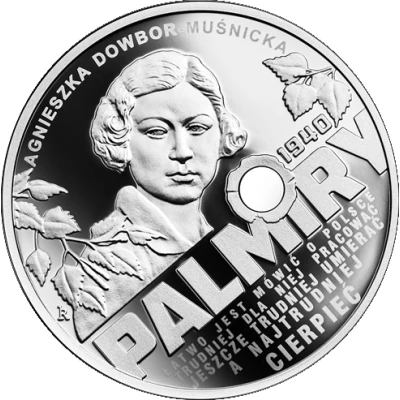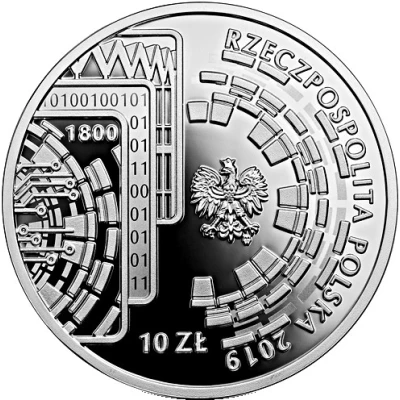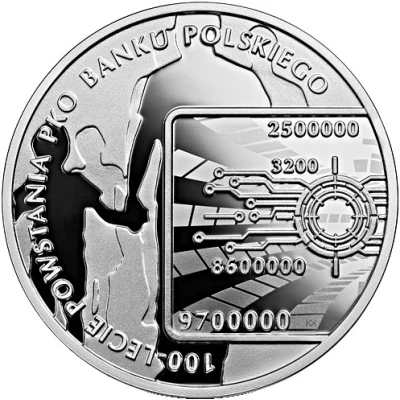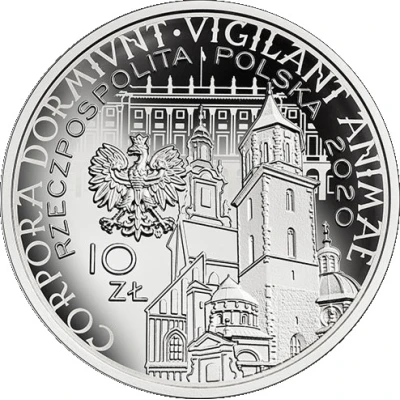


© Narodowy Bank Polski
10 Zlotys Katyń – Palmiry
2020 year| Silver (.925) | 14.14 g | 32 mm |
| Issuer | Poland |
|---|---|
| Period | Third Republic (1989-date) |
| Type | Non-circulating coin |
| Year | 2020 |
| Value | 10 Zlotys (10 Złotych) 10 PLN = USD 2.54 |
| Currency | Fourth Zloty (1995-date) |
| Composition | Silver (.925) |
| Weight | 14.14 g |
| Diameter | 32 mm |
| Shape | Round |
| Technique | Milled |
| Orientation | Medal alignment ↑↑ |
| Updated | 2024-10-07 |
| Numista | N#197272 |
|---|---|
| Rarity index | 93% |
Reverse
Script: Latin
Lettering:
AGNIESZKA DOWBOR-MUŚNICKA
1940
PALMIRY
Designer: Robert Kotowicz
Edge
Plain
Comment
Janina Lewandowska and Agnieszka Dowbor-Muśnicka were born into a patriotic family, where the love of the homeland constituted an integral part of children’s upbringing. Their father, General Dowbor-Muśnicki, was the founder and organiser of the First Polish Corps formed in Russia in 1917, and later the commander of the victorious Greater Poland uprising between 1918 and 1919. In the war with Bolshevik Russia he participated in the fighting for Lvov. Following the cessation of hostilities, General Dowbor-Muśnicki devoted himself to running a land estate purchased in Lusowo in Greater Poland in 1919. His elder daughter, Janina, was born on 22 April 1908 in Kharkov, but her youth and adult life were linked to Lusowo and Poznań. As a teenager she took to sports – she practised horse-riding and skiing. Having graduated from the Generałowa Zamoyska High School, she enrolled in the piano class at the State Conservatory of Music in Poznań, where she studied singing as well. Initially, she intended to pursue a singer’s career. However, in the meantime she became fascinated by gliding and parachute jumping. She became a member of the Poznań Aeroclub and she completed a flight course at the Poznań airport of Ławica. At one of the gliding shows she got to know her future husband, Mieczysław Lewandowski, an instructor pilot. They got married in June 1939. Soon after the outbreak of the war, Janina and part of the air base personnel from Poznań were transferred to the east. There, they were taken by surprise by the Soviet invasion of 17 September. Janina together with Captain Józef Sidor went to Soviet captivity. She was initially held in the Ostaszków and then in the Kozielsk camp. She was killed in Katyń by her captors on her 32nd birthday, 22 April 1940. General Dowbor-Muśnicki’s second daughter, Agnieszka, was born on 7 September 1919 in Lusowo, in independent Poland. Unfortunately, approximately a year after her birth, on 10 August 1920, died her mother and the General’s wife, Agnieszka Dowbor-Muśnicka nee Korsuńska.Agnieszka was initially home-schooled and later on, similarly to her elder sister, she attended and graduated from the Generałowa Zamoyska High School. From the time of her childhood she liked working in the garden and around the family estate, so she enrolled in the State School of Horticulture in Poznań. The outbreak of the war interrupted her studies. Since she was in danger of arrest by the Germans due to her father’s merits in the struggle for the incorporation of the province of Greater Poland into Poland, she decided to move to Warsaw in autumn 1939. Her fate in the German-occupied Polish capital has not been well documented. It is known that she became member of the underground “Wilki” (Wolves) Military Organisation, a group which had, for example, the famous Polish sportsman Janusz Kusociński in its ranks. In spring 1940 Agnieszka was arrested and held at the Pawiak prison. She was killed in Palmiry on 21 June 1940, two months after Janina.The reverse of the coin features a portrait of Agnieszka Dowbor-Muśnicka with a quotation carved by an inmate in one of the cells at Aleja Szucha prison in Warsaw: “It is easy to talk about Poland. It is more difficult to work for it and even more difficult to die for it. And the most difficult is to suffer for it”. The same inscription can be found at the Palmiry cemetery. The obverse of the coin features the portrait of Janina Lewandowska and a fragment of Bogurodzica, an old Polish battle song, whose text was engraved on the underground bell at the Katyń cemetery. Janina Lewandowska and Agnieszka Dowbor-Muśnicka symbolise all the victims of crimes perpetrated in Katyń and at Palmiry 80 years ago.Bartłomiej Grudnik
Source
https://www.nbp.pl/banknoty_i_monety/monety_okolicznosciowe/2020/2020_03___katyn_palmiry_en.pdf
Date of issue 19-03-2020
Interesting fact
The 10 Zlotys (Katyń – Palmiry 1940) 2020 coin from Poland is a non-circulating commemorative coin that honors the victims of the Katyn massacre, which occurred during World War II. The coin's design features an image of a broken tree, symbolizing the tragic event, and the inscription "Katyń – Palmiry 1940" to commemorate the 80th anniversary of the massacre. The coin is made of silver (.925) and weighs 14.14 grams.
Price
| Date | Mintage | VG | F | VF | XF | AU | UNC |
|---|---|---|---|---|---|---|---|
| 2020 MW | 11000 | - | - | - | - | - | - |
Values in the table are based on evaluations by sales realized on Internet platforms. They serve as an indication only for 10 Zlotys (Katyń – Palmiry 1940) 2020 coin.



